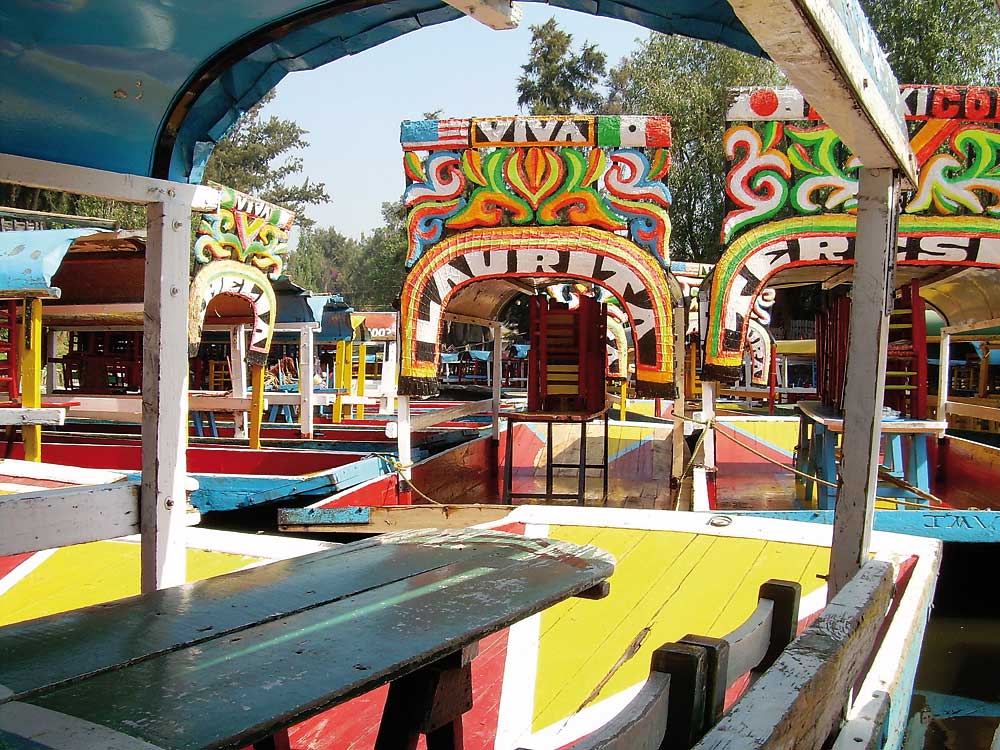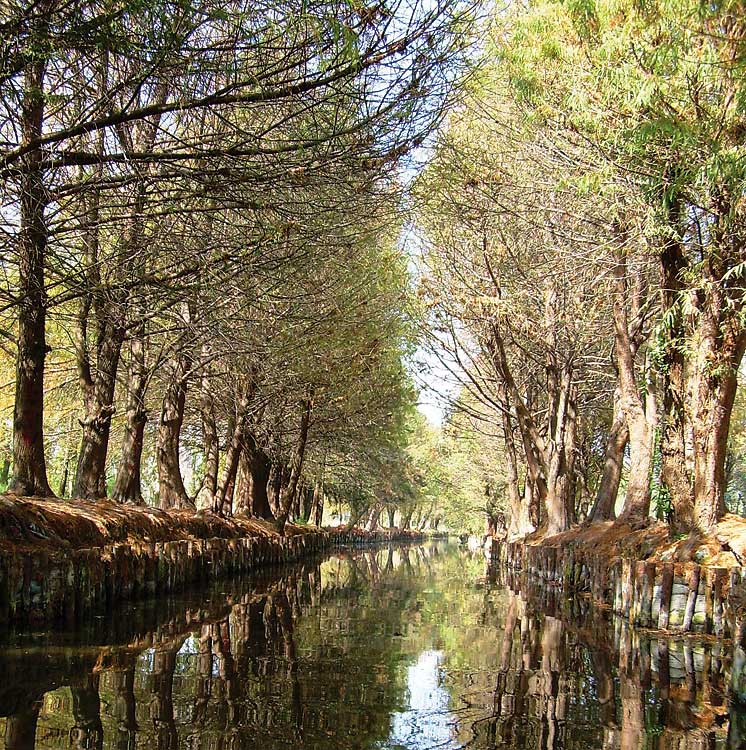
Wine
January 22, 2016
Are our banks any safer?
February 11, 2016Dating back to before Aztec times, the once-extensive canal system of Xochimilco endures as a quiet refuge in the midst of frenetic Mexico City. Now just a fragment of its former range, Xochimilco clings to life. In many ways it is emblematic of the wider struggle of Mexico to balance its rich history with its complex and challenging present and its fragile – but hopeful – future.
By Caroline Udall
It is the bleak midwinter.
Well, somewhere it is. In Mexico City, though, summer is icumen in – and it’s icumen a bit unseasonably even for here. It’s warm, edging toward hot outside. The sky is robin’s-egg blue and the air is blessedly free of smog. It’s perfect weather for a day trip to Xochimilco – the famous “floating gardens of Mexico City.”
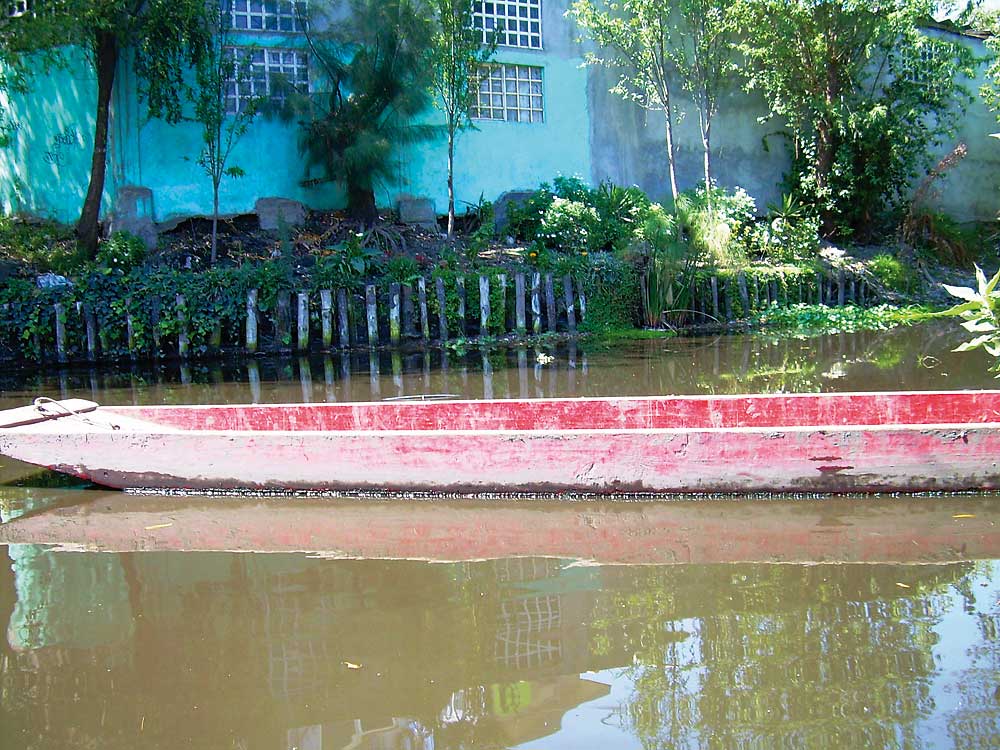
My friends Rosa and Eduardo have been patiently carting me everywhere for a week now, and this outing was to have been particularly spectacular, since Eduardo has contacts – insiders, even – at Xochimilco. But the night before we’re to go, their son, seven-year-old Lalo, is felled by a cold and confined to bed. Rosa insists we continue with our plans, however. If we don’t go, I won’t get another chance before I have to return to the frozen wastes of the North.
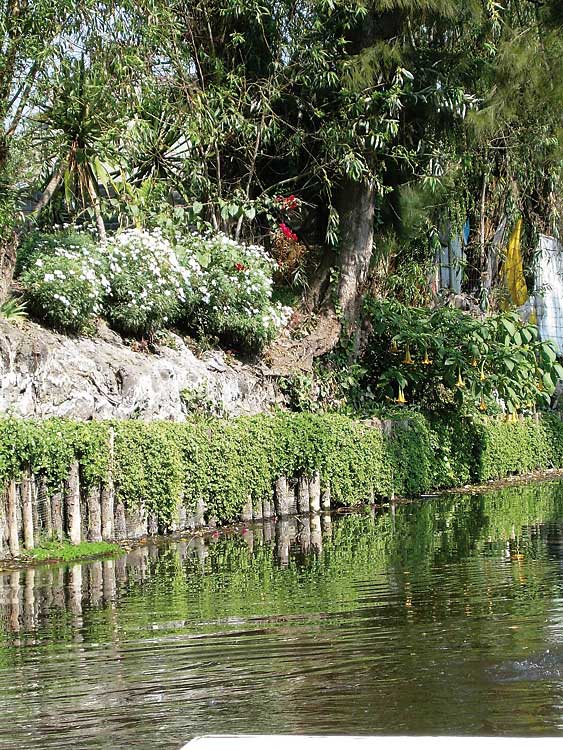
So leaving Lalo (in mourning) and Rosa (in attendance) behind, Eduardo and I load up on this gorgeous Sunday morning and head south on the Periferico – the great ring road that traces a meandering loop around the sprawling city. As he deftly navigates the infamous Mexico City traffic, Eduardo gives me a running commentary on the city of his birth.
“To me, it’s a miraculous city,” he says, by way of summary.
Miraculous? How so?
“Because it works! There are some 21 or 22 million of us! Just the fact that it functions on a daily basis is a miracle. It’s not always pretty or perfect, but we make it work. The city keeps on going no matter what.”
Xochimilco is nothing if not an expression of this simple fact of life in Mexico City, as we shall see.
We pull off the Periferico and head east, eventually finding our destination by the simple expedient of following the many signs that say “Xochimilco.”
There are nine landings – called embarcaderos – where anyone can hire a trajinera, the wide, flat-bottomed canoes that are poled about the canals by remeros – Xochimilco’s gondoliers. We pull right up to Embarcadero Fernando Celada, which sits hard by the busy Avenida Guadelupe I. Ramirez. In ten steps, we’re off the road and inside the embarcadero, where Eduardo’s friend and former student, Clemente, is waiting to greet us. Down a short, steep flight of steps, and the sounds of traffic have already receded.
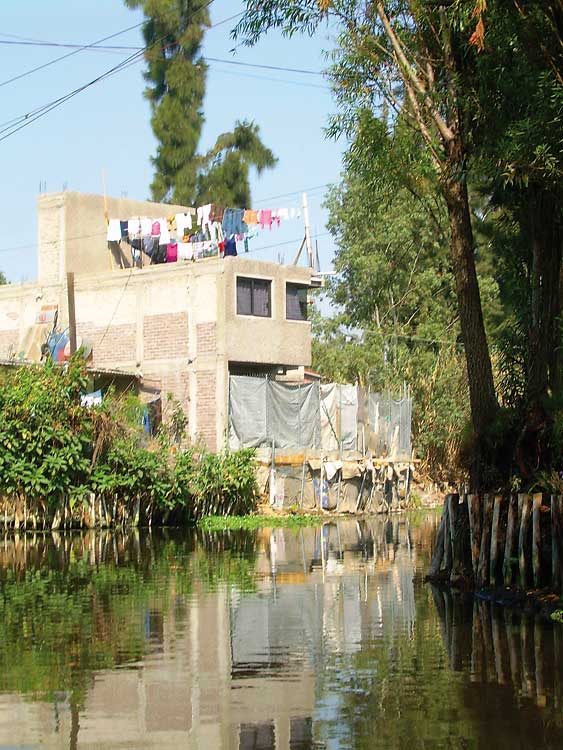
It’s early and nearly all of the trajineras are docked. The Frida, Clemente’s family trajinera, is crammed in the middle of a scrum of other crafts. But like any true capitaleño, Clemente is unfazed by the crowds. He jumps down from the steps onto the nearest trajinera and begins hopping from one boat to the next until he reaches Frida. Eduardo and I do our best to follow.
Having arrived on board with only a few wobbly moments, we take a seat as Clemente begins shouldering the Frida out into the open canals. He muscles empty boats to one side with his pole, or leans into them with his back and shoulders. The few other remeros that are up and about lend him a hand when it becomes strategically necessary. It’s all done with a cheerful absence of any fuss whatsoever. Within minutes we break free of the crush and are away.
It’s as if we’ve passed into another world. The canals are still relatively empty. The water, which looks (and unfortunately is) quite dirty, doesn’t have the stench you might associate with somewhat stagnant, polluted canal water. The mature trees, abundance of wildlife, and teeming plant life soon fill up the space that the city noise and traffic have vacated.
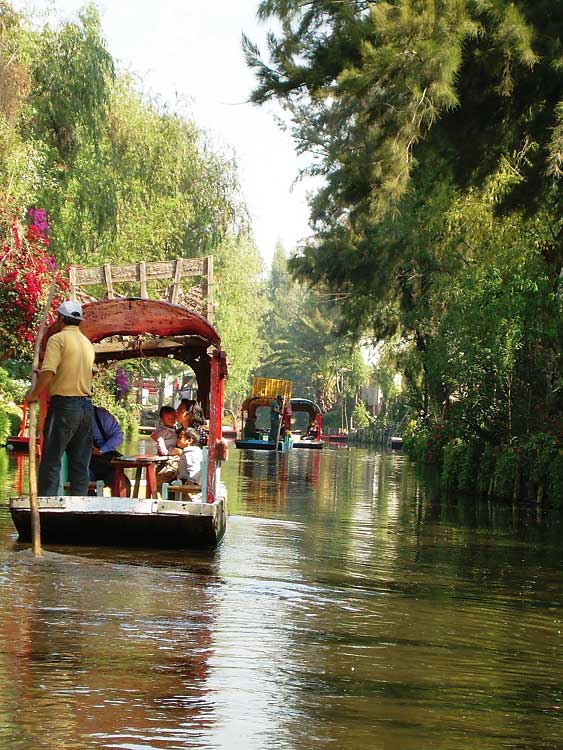
This is deceptive, of course, as Xochimilco sits in the middle of one of the most densely populated areas on the planet. While I see abundant signs of human habitation – everything from bridges, to elegant mansions, to improvised shacks, to swanky-looking rowing clubs – they all have the feeling of being in an isolated area. We see them unfold in a very stately procession; they sort of spring out as we come around corners, or peep over the tops of walls, or are glimpsed through a grove of trees. From the canal-level, you feel as if you’re in a bustling little village. Pull back a bit, though, and it’s a different story. Recently, I found the section of canal we’d travelled on Google Earth. From above, you can see that only a thin veneer of green edges the canals. Behind it, the city encroaches. The tranquil waterways are like green shards shot through teeming working class neighborhoods. Xochimilco jostles cheek-by-jowl with the modern urban beast in an uneasy co-existence. By many measures, the beast is winning.
The word Xochimilco is Nahuatl for “fields of flowers.” The fields in question are the artificial islands, called chinampas, built for cultivation in the shallow waters of the lakes on which Mexico City is built. They are often called “floating gardens,” but this is a misnomer. The islands do not float. Chinampas are constructed by staking out an area on the shallow lakebed and lining it with wattle or mesh. This framework is filled with sludge and mud from the lakebed itself, eventually building a small island rising slightly above the level of the water. Trees are planted along the edges to stabilize the borders. The original canals – often the width of only one canoe – ran between these islands and the farmers would trawl them in trajineras as they tended the crops.
The Aztecs are often credited with developing this system, but in fact they co-opted it. It predates them by at least 1000 years. Groups living in the Valley of Mexico developed the system, called milpas, into one of the most productive farming methods ever known. A chinampa could produce as many as seven crops in a season, and irrigation was unnecessary as water seeped into the soil bed from the lake itself.
Xochimilco was a large chinampa area that the Aztecs took over and expanded through military conquest. They also built chinampas ringing their capital of Tenochtitlán. Only a small percentage of their population was engaged in food production when Cortés arrived. The farmers of the milpas fed the empire.
The Spaniards, of course, put a stop to all this when they conquered the Aztecs and set about draining the lakes. Only a small belt of the original extent of the system has survived, but it has been surprisingly resilient over the centuries. In fact, a main canal for transport of goods that went into the center of Mexico City itself survived into the 20th century.
But the degradation of the canal system has only accelerated as Mexico City has exploded in size over the last century. Xochimilco, which had been an independent entity, was brought into the capital as a borough in the 1920s. In the 1950s, the springs that fed the lake were co-opted (again!) for drinking water for the thirsty metropolis. Most of the water in the canals now is treated water (not potable because of bacteria and heavy metals) that is pumped back into the canals. This cannot keep up with the rapidly dropping water table, however, and the canals are slowly drying up, or in some cases being actively filled in.
Add a burgeoning population, with illegal settlements springing up in protected ecological areas as well as the tourist areas, plus invasive plants and wildlife that choke canals and push out native flora and fauna, and the threat to the remaining system has become critical.
Xochimilco was named a UNESCO World Heritage site in 1987 in an effort to protect it. So far it hasn’t helped much. Mexico City’s environmental secretary, Maria Teresa Delgado, was quoted in the Washington Post recently as saying that the solutions to saving the canals are well-known, but that the paucity of funds and the proliferation of responsible agencies, with poor bureaucratic coordination between them have combined to frustrate conservation efforts.
Still, on a Sunday at the canal with Eduardo, Xochimilco seems like a thriving village market, a nature preserve, and a party all rolled into one.
On the water, while the problems are in evidence, if you know what to look for, the place seems vital. In one direction, you can see a weeded-up canal that ends abruptly in a tiny cluster of ad hoc homes. But in the other you also see canoes (the kind more familiar to American eyes) full of harvested flowers, ready for market; skinny kids launching beat-up trajineras from ramshackle docks; egrets, ducks, and other, more exotic wildlife flitting here and there amongst the human traffic. There are trajineras loaded with rugs, blankets, and other goods to sell. Vendors ply the waters selling all kinds of food and drinks – popcorn, candy, soda, and more substantial, traditional fare.
In fact, says Clemente, we’re out looking for one of these vendors in particular. Doña Mari, he says, has been cooking and selling her excellent food on the canals for decades. Family members (these days, it’s her grandsons) pole her trajinera up and down the canals while she cooks at a stove on the boat – all to your order. Clemente’s told Doña Mari that we’ll be on the water this morning. She’s said just to come find her; she’ll be out cooking. He’s keeping an eye peeled, he tells us. Meanwhile, we keep wandering.
We emerge from a long, narrow canal into a huge open area that Clemente explains is called the Laguna del Toro. Six or seven different canals feed into this open area, which has an island just slightly off-centre in the middle. Every year, in the evening on the Day of the Dead, a theatrical representation of the legend of La Llorona is performed on the island. Clemente describes it as he sweeps one arm around, encompassing the large open space.
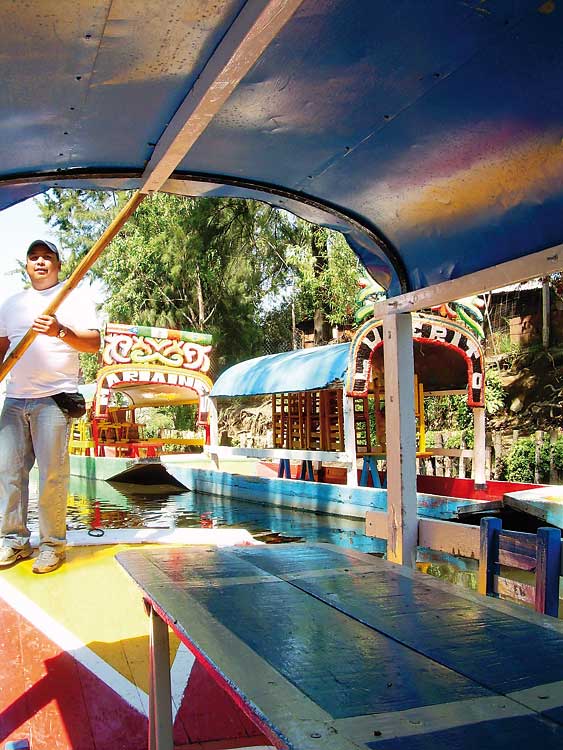
“Just imagine,” he says, “this whole area, wall-to-wall trajineras. You can walk across the laguna and back on them. People come with their families and eat and drink, and after dark they watch the play from the trajineras.” It’s a Xochimilco tradition, he says, part of the unique, separate identity of the barrio.
Clemente himself and his family are part of that unique culture. He comes from a long line of Xochimilco gondoliers. “Not just anybody can come in here and start poling a trajinera,” he smiles. “No, there are certain families who have traditionally been on the canals. They all have a space and it’s preserved for them, even if they aren’t using it.”
We’ve moved back into the canals as Clemente tells his story, and suddenly he interrupts himself. He’s spotted Doña Mari. We pull up alongside and rope the two trajineras together.
Doña Mari sits at her large grill with a cooking fire blazing merrily beneath it, smoke pouring out into the morning air. She favours us with a slow smile, and passes a laminated menu over. Eduardo and I choose from the menu and we chat with her and her grandson as she cooks us up our order.
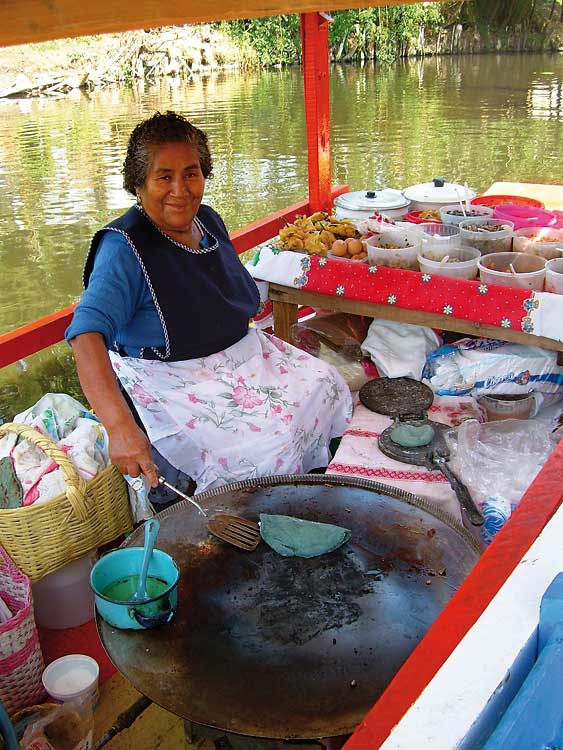
Just then, some mariachis float by.
I am not making this up.
Mariachis are common on the canals, and they’ll stop and play on demand. When he spots them, Clemente delightedly gestures them over, and they tie up to Frida on the opposite side. They also have a menu with a list of their prices. I choose a song and they obligingly belt it out. Eduardo, gallantly, pays the fiddler for me.
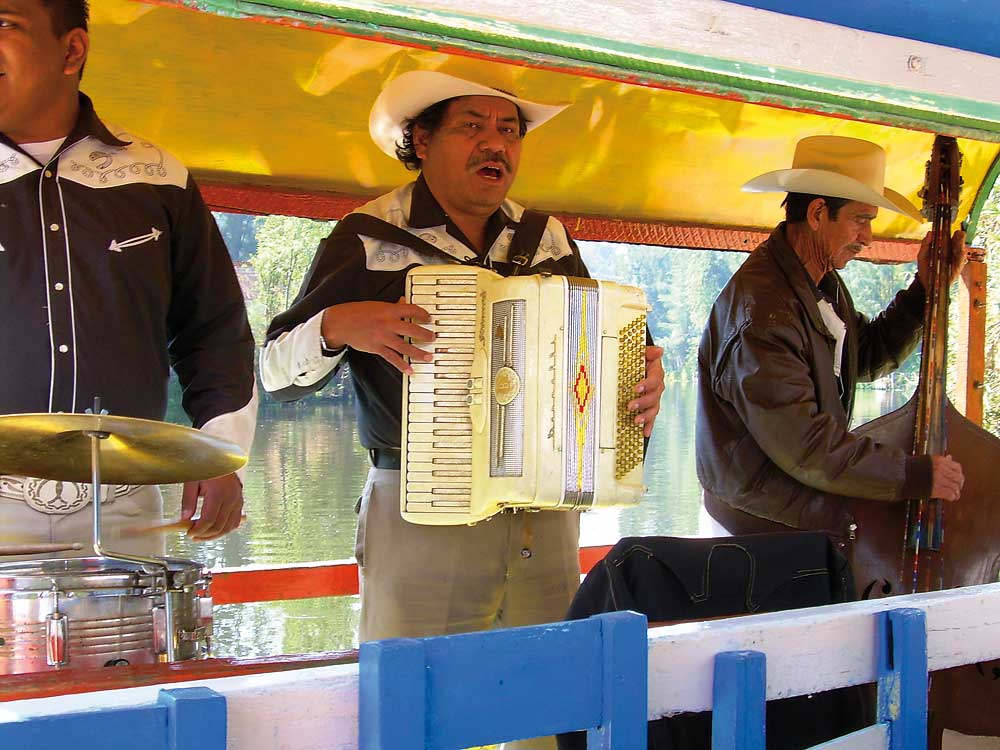
It just about makes my morning perfect. We sit back and listen to the mariachis while Doña Mari’s savoury food sizzles on the grill. I feel as though I’m sitting in the middle of a veritable sandwich of mejicanismo. I have a hard time not tearing up. It is more perfect than I could have imagined.
We finish our food (delicious!), thank the mariachis (beautiful!), and start making our way back to the landing. On the way Clemente turns down an empty canal that runs along what are obviously very old, disused chinampas. It’s beautiful – the canal is lined with tall, stately trees. But the chinampa itself is overgrown. It also clearly could be usable land. I ask Clemente if any of them are under cultivation. He shrugs and says no, not really. There are some that still cultivate flowers, but not really anything else.
He’s right as far as parts of Xochimilco in the barrio of Nativitas. Those areas cater mostly to tourists. In San Gregorio, another area of Xochimilco, flower production is thriving on the chinampas, though that production is fairly industrialised, using artificial fertilisers and pesticides – two substances that are inimical to the life of the canal system. In the area of Cuermanco, there are ecological reserves where farmers are attempting to revive the system, growing food crops as well as flowers, and using the traditional methods of irrigation, fertilisation, and maintenance of the chinampas.
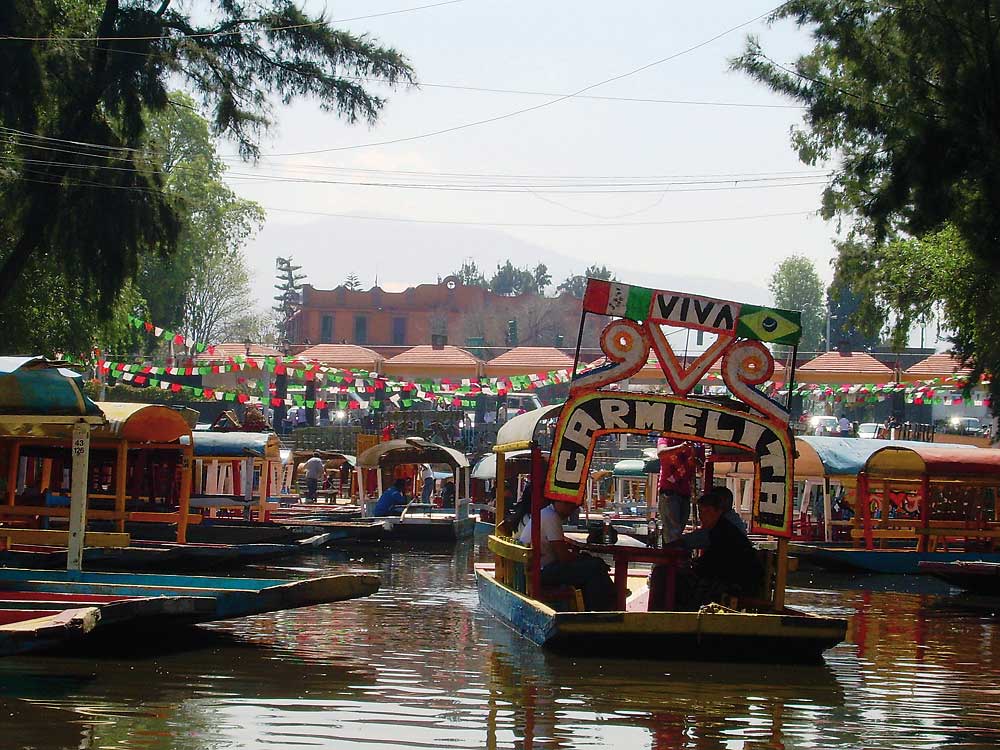
These attempts to work them as in ancient times are a ray of hope in the dark picture for Xochimilco. Aside from everything else, if the chinampas aren’t worked and maintained, they will dry up completely. This will be an ecological disaster for Mexico City, in and of itself. Dust Bowl-type conditions could result, and in fact this has happened in the city’s past during the times when the Spaniards were draining the lakes.
We’re getting close to the embarcadero and the canals are filling up with the usual Sunday-morning revellers. We glide beneath lilies that look like something out of Rivera, as we shove back through the scrum to the landing. We take our leave of Clemente and Frida, and plunge into the never-ceasing chaos of the city. The morning already seems somewhat dreamlike. But it has been, in many ways, an experience of the essence of Mexico.



